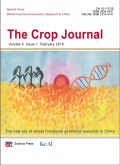- 钛学术文献服务平台 \
- 学术期刊 \
- 农业科学期刊 \
- 农作物期刊 \
- 作物学报(英文版)期刊 \
null
A sulfotransferase gene BnSOT-like1 has a minor genetic effect on seed glucosinolate content in Brassica napus
基本信息来源于合作网站,原文需代理用户跳转至来源网站获取
摘要:
The theory and associated selection methods of classical quantitative genetics are based on the multifactorial or polygene hypothesis. Major genes or quantitative trait loci (QTL) in modern quantitative genetics based on a"major gene plus polygenes"genetic system have been paid much attention in genetic studies. However, it remains unclear how the numerous minor genes act, although the polygene theory has sustained genetic improvement in plants and animals for more than a hundred years. In the present study, we identified a novel minor gene, BnSOT-like1 (BnaA09g53490D), which is a sulfotransferase (SOT) gene catalyzing the formation of the core glucosinolate (GSL) structure in Brassica napus. This gene has been occasionally found during investigations of plant height-related genes, but has not been identified by QTL mapping because of its small phenotypic effects on GSL content. The overexpression of BnSOT-like1 up-regulated the expression of aliphatic GSL-associated genes, leading to a high seed aliphatic GSL content, and the overexpression of the allelic gene Bnsot-like1 did not increase seed GSL content. These findings suggest that the SOT gene has a marked effect on a quantitative trait from a reverse genetics standpoint, but a minor effect on the quantitative trait in its natural biological state. Because of the redundancy of GSL biosynthetic genes in the allotetraploid species B. napus, mutations of a single functional gene in the pathway will not result in significant phenotypic changes, and that the genes in biosynthetic pathways such as BnSOT-like1 in our study have minor effects and may be called polygenes in contrast to the reported three regulatory genes (BnHAG1s) which strongly affect GSL content in B. napus. The present study has shed light on a minor gene for a quantitative trait.

推荐文章
期刊_丙丁烷TDLAS测量系统的吸收峰自动检测
带间级联激光器
调谐半导体激光吸收光谱
雾剂检漏 中红外吸收峰 洛伦兹光谱线型
不同盐度、温度及光照对漂浮浒苔生理生态的影响
浒苔
盐度
温度
光照
生理生态
期刊_联合空间信息的改进低秩稀疏矩阵分解的高光谱异常目标检测
高光谱图像
异常目标检测 低秩稀疏矩阵分解 稀疏矩阵 残差矩阵
内容分析
关键词云
关键词热度
相关文献总数
(/次)
(/年)
引文网络
引文网络
二级参考文献 (65)
共引文献 (61)
参考文献 (49)
节点文献
引证文献 (0)
同被引文献 (0)
二级引证文献 (0)
1973(1)
- 参考文献(0)
- 二级参考文献(1)
1980(1)
- 参考文献(0)
- 二级参考文献(1)
1987(1)
- 参考文献(0)
- 二级参考文献(1)
1989(1)
- 参考文献(0)
- 二级参考文献(1)
1992(1)
- 参考文献(0)
- 二级参考文献(1)
1994(1)
- 参考文献(0)
- 二级参考文献(1)
1995(3)
- 参考文献(0)
- 二级参考文献(3)
1996(3)
- 参考文献(1)
- 二级参考文献(2)
1997(2)
- 参考文献(2)
- 二级参考文献(0)
1999(1)
- 参考文献(0)
- 二级参考文献(1)
2000(2)
- 参考文献(1)
- 二级参考文献(1)
2001(3)
- 参考文献(2)
- 二级参考文献(1)
2002(2)
- 参考文献(2)
- 二级参考文献(0)
2003(2)
- 参考文献(1)
- 二级参考文献(1)
2004(5)
- 参考文献(3)
- 二级参考文献(2)
2005(2)
- 参考文献(1)
- 二级参考文献(1)
2006(4)
- 参考文献(1)
- 二级参考文献(3)
2007(8)
- 参考文献(3)
- 二级参考文献(5)
2008(4)
- 参考文献(0)
- 二级参考文献(4)
2009(4)
- 参考文献(1)
- 二级参考文献(3)
2010(8)
- 参考文献(4)
- 二级参考文献(4)
2011(7)
- 参考文献(2)
- 二级参考文献(5)
2012(8)
- 参考文献(0)
- 二级参考文献(8)
2013(6)
- 参考文献(3)
- 二级参考文献(3)
2014(12)
- 参考文献(6)
- 二级参考文献(6)
2015(8)
- 参考文献(5)
- 二级参考文献(3)
2016(8)
- 参考文献(6)
- 二级参考文献(2)
2017(2)
- 参考文献(1)
- 二级参考文献(1)
2018(3)
- 参考文献(3)
- 二级参考文献(0)
2019(1)
- 参考文献(1)
- 二级参考文献(0)
2020(0)
- 参考文献(0)
- 二级参考文献(0)
- 引证文献(0)
- 二级引证文献(0)
引文网络交叉学科
相关学者/机构
期刊影响力
作物学报(英文版)
主办单位:
中国作物学会
中国农业科学院作物科学研究所
中国科技出版传媒股份有限公司
出版周期:
双月刊
ISSN:
2095-5421
CN:
10-1112/S
开本:
16开
出版地:
北京市海淀区中关村南大街12号
邮发代号:
80-668
创刊时间:
2013
语种:
eng
出版文献量(篇)
556
总下载数(次)
0
总被引数(次)
870
期刊文献
相关文献
推荐文献
- 期刊分类
- 期刊(年)
- 期刊(期)
- 期刊推荐

 免费查重
免费查重










